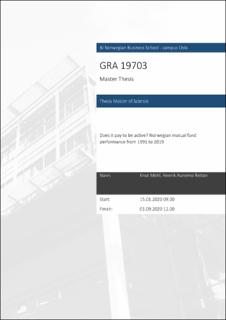| dc.contributor.author | Mehl, Knut | |
| dc.contributor.author | Reitan, Henrik Aunemo | |
| dc.date.accessioned | 2020-11-19T13:21:13Z | |
| dc.date.available | 2020-11-19T13:21:13Z | |
| dc.date.issued | 2020 | |
| dc.identifier.uri | https://hdl.handle.net/11250/2688733 | |
| dc.description | Masteroppgave(MSc) in Master of Science in Business, Finance - Handelshøyskolen BI, 2020 | en_US |
| dc.description.abstract | This research paper shows that Norwegian active funds have first-order stochastically dominated
Norwegian index funds for the subperiod 1991 to 2005, measured by net returns, not accounting
for redemption and subscription fees. The same holds for large investors between 2006 to 2019.
Our simulation studies show that the historical probability of active funds yielding a greater return
than index funds is about 60% and notably above 50% for the first and most recent subperiod,
respectively, for (most) investors when sorted on investment size with holding periods between 1
to 5 years. The probability is barely affected by redemption and subscription fees. Our thesis also
provides further evidence that the traditional benchmark models used in mutual fund literature are
sensitive to the choice of market benchmark and factor model, and therefore have severe
limitations in their ability to explain whether active funds outperform index funds. | en_US |
| dc.language.iso | eng | en_US |
| dc.publisher | Handelshøyskolen BI | en_US |
| dc.subject | finans | en_US |
| dc.subject | finance | en_US |
| dc.title | Does it pay to be active? Norwegian mutual fund performance from 1991 to 2019 | en_US |
| dc.type | Master thesis | en_US |

